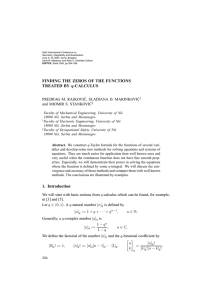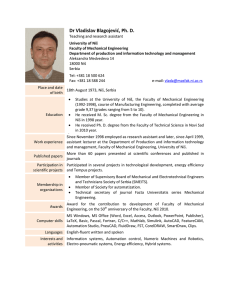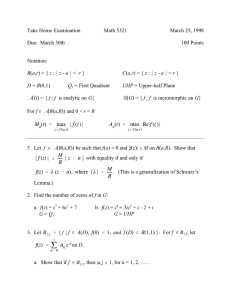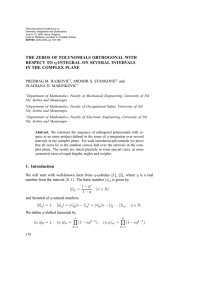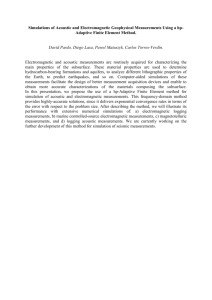modeling of penetrating electromagnetic fields of mobile
advertisement
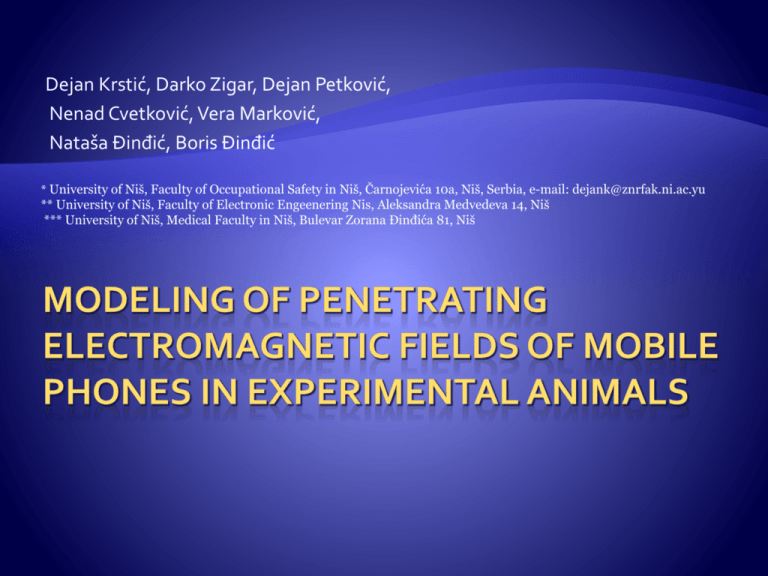
Dejan Krstić, Darko Zigar, Dejan Petković, Nenad Cvetković, Vera Marković, Nataša Đinđić, Boris Đinđić * University of Niš, Faculty of Occupational Safety in Niš, Čarnojevića 10a, Niš, Serbia, e-mail: dejank@znrfak.ni.ac.yu ** University of Niš, Faculty of Electronic Engeenering Nis, Aleksandra Medvedeva 14, Niš *** University of Niš, Medical Faculty in Niš, Bulevar Zorana Đinđića 81, Niš electromagnetic radiation, electromagnetic pollution or electromagnetic smog undesirable phenomena (not confirmed by the good) biological effects, performed on experimental animals. Fig. 1 - Experimental animals with a mobile test phone [3] Penetrating electromagnetic field is almost impossible to measure Penetrating field in the tissue must be calculated Numerical methods in electromagnetics (integral method, differential and variation method) Commercial software packages Model of the source (mobile phone) with the antenna pattern characteristic, Experimental animal model with the actual characteristics of tissues Model of wave propagation in half-conductive environment, i.e. the choice of numerical simulation methods (FDM, MoM, FDTD, FIT, etc.). Three types of mobile Mono-block phone with a with monopole antenna which is placed on the top of the mobile phone (a), Mono-block phone with a planar inverted-F antennas - PIFA (b and c) Flip-down phone with a PIFA (d). FDTD solves Maxwell’s equations in the time domain. This means that the calculation of the electromagnetic field values progresses at discrete steps in time. Main reason for using the FDTD approach is the excellent scaling performance of the method as the problem size grows. As the number of unknowns increases, the FDTD approach quickly outpaces other methods in efficiency. FDTD has been identified as the preferred method for performing electromagnetic simulations for biological effects from wireless devices [3, 4, 7]. Simulation program was carried out REMCOM XFDTD [8] It is significant to known the real position of all tissues in animal body and their electromagnetic characteristics. These complimentary animal meshes are provided by The Radio Frequency Branch of the Human Effectiveness Division of the Air Force Research Lab at Brooks Air Force Base [11]. Real 3D model with all tissue and resolution of model is 1mm. Model have 47 diferent tissues and parts. Biol. Material Skin ligaments fat blood muscle grey matter white matter eye sclera nerve spine stomach kidneys testicles eye lens heart pancreas body fluid liver Conductivity (S/m) 0.693293 0.951258 0.0529249 1.86817 1.1975 1.0092 2.42613 1.68613 0.606129 1.30105 1.349 1.34108 0.908172 1.722 1.66 2.899 1.33 Relative Permittivity 39.5868 46.7184 4.78598 55.4796 60.7263 51.8029 68.2932 67.9 33.3591 71.7763 53.898 62.6033 51.4785 55.744 57.2 67.24 43.4 Density (kg/m3) 1125 1220 916 1058 1046.9 1038 1038 1026 1038 1050 1150 1044 1530 1029.8 1045 1010 1030 In the simulation process with REMCOM XFDTD program is used a source of power 1W. The results for the component EM fields in free space have been compared with the values measured by field meter AARONIA HF6080. The results matched have been satisfactory. Simulated is real cage with rats and mobile phone in two possition. Case 1 - Antena is near to the head Case 2 - Antena is near to the stomach Electrical field Electric field in model of rat Electrical field Case 1 – Distribution of EM field Electric field in model of rat Distribution of SAR in trunk of model cross section liver Distribution of SAR in head of model cross section of brain and eye tissue Case 2 – Distribution of EM field Electric field in model of rat Distribution of SAR in trunk of model cross section liver Distribution of SAR in head of model cross section of brain and eye tissue Tab. 2 - Calculation Electrical field in some part of body in model of rat. Electrical field E(V/m) Position of the antenna Organ Average Next to the head (Case 1) Next to the trunk of the body (Case 2) liver 5.61 10.8 8.205 brain 16.9 7.65 12.275 eye 13.8 4.31 9.05 Tab. 3 - Calculation SAR in some part of body in model of rat. SAR(W/kg) Position of the antenna Organ liver brain eye Next to the trunk Next to the head of the body (Case 1) (Case 2) 0.0132 0.166 0.148 0.046 0.147 0.026 Average 0.089 0.097 0.086 The results of electric field distribution in the rats bodies suggest that there is an unequal distribution of the fields, which depends on the position of the sources and characteristics of each tissue. It is important to note that there are tissues which absorb 10 times higher amounts of energy the tissues adjacent to them. Precise locate point of maximum SAR indicate the possible biological effects of radiation on these tissues. These effects were presented and discussed in various papers which analyzed biochemical indicators of the effects of electromagnetic fields. Such calculation enables us to develop the biological quantifiers of the effects of electromagnetic fields, which is studied by dosimetry. Thus obtained quantifiers could be applied on the human tissue. Acknowledgement:This work was supported by the project III43011 and III43012 of the Serbian Ministry of Education and Science.
